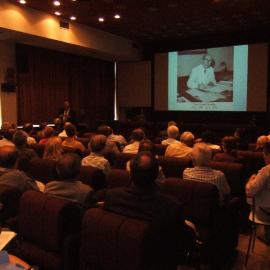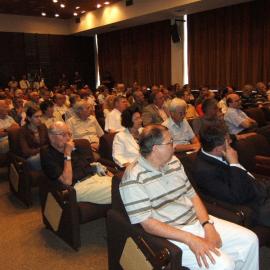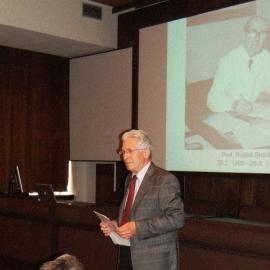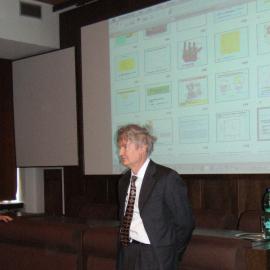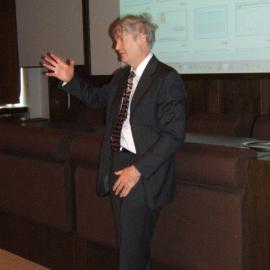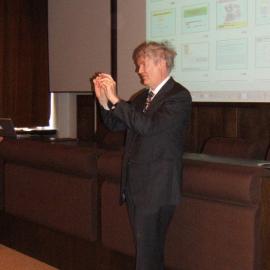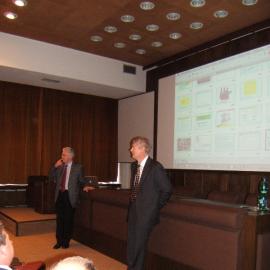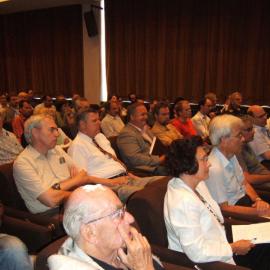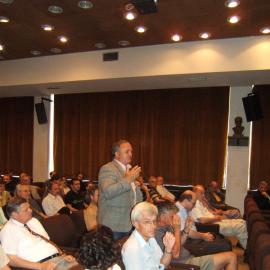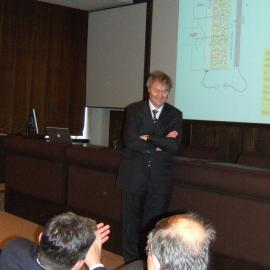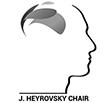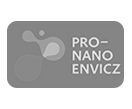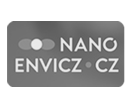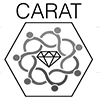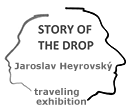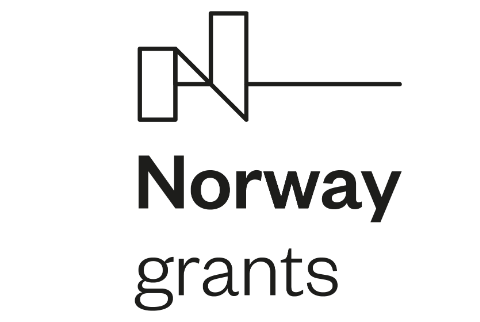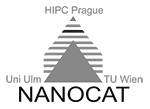Michael Graetzel (Ecole Polytechnique Federale de Lausanne, Switzerland)
Lecture Type
Year
2008
The interview of Czech Radio CRO3 VLTAVA with professor Graetzel (broadcast - July 7, 2008)
Part I of the interview of Czech Radio LEONARDO with professor Graetzel (broadcast - June 12, 2008)
Part II of the interview of Czech Radio LEONARDO with professor Graetzel (broadcast - June 12, 2008)
"Mesoscopic Electrodes for Generation and Storage of Electric Power from Sunlight"
The lecture covers our recent research on mesoscopic electrodes that made up of a network of nanometer-sized particles such as titanium dioxide, zinc oxide, tungsten trioxide, Fe2O3 or LiMnPO4. The pores between the particles are filled with an electrolyte or p-type semiconductor, in this way interpenetrating bicontinuous network composites are formed which are phase-separated by a hetero-junction. Electrons can percolate rapidly across the network of nanoparticles allowing the huge junction area to be addressed electronically. Intriguingly, cross surface electron and hole transfer in self-assembled monolayers (SAM) of redox-active molecules has also been observed. These mesoscopic oxide electrodes show great promise for a number of applications, such as high power lithium insertion batteries photo-electrochemical cells for solar hydrogen generation and dye-sensitized solar cells (DSCs). The DSC achieves currently a conversion efficiency of over 11 percent and exhibits excellent long term stability, rendering it a credible alternative to conventional silicon based devices. These new cells offers opportunities for applications in building integrated photovoltaic device and light weight solar power supplies. Recently large-scale production of flexible DSC modules has started.
Literature
1) B. O’Regan and M. Graetzel, “A Low Cost, High Efficiency Solar Cell" Nature, London, 353, 737 (1991).
2) U. Bach, D. Lupo, P. Comte, J. E. Moser, F. Weissörtel, J. Salbeck, H. Spreitzert and M. Graetzel, “Solid State Dye Sensitized Cell Showing High Photon to Current Conversion Efficiencies” Nature 395, 550 (1998).
3) M. Graetzel, “Photoelectrochemical Cells " Nature, London, 414, 338, 2001.
Professor M. Graetzel
Laboratory of Photonics and Interfaces,
Ecole Polytechnique Fédérale de Lausanne
CH-1015 Lausanne Switzerland
e-mail: michael.graetzelepfl.ch
June 5, 2008
Photos: Archive JHI - K.Stejskalová.
Part I of the interview of Czech Radio LEONARDO with professor Graetzel (broadcast - June 12, 2008)
Part II of the interview of Czech Radio LEONARDO with professor Graetzel (broadcast - June 12, 2008)
"Mesoscopic Electrodes for Generation and Storage of Electric Power from Sunlight"
The lecture covers our recent research on mesoscopic electrodes that made up of a network of nanometer-sized particles such as titanium dioxide, zinc oxide, tungsten trioxide, Fe2O3 or LiMnPO4. The pores between the particles are filled with an electrolyte or p-type semiconductor, in this way interpenetrating bicontinuous network composites are formed which are phase-separated by a hetero-junction. Electrons can percolate rapidly across the network of nanoparticles allowing the huge junction area to be addressed electronically. Intriguingly, cross surface electron and hole transfer in self-assembled monolayers (SAM) of redox-active molecules has also been observed. These mesoscopic oxide electrodes show great promise for a number of applications, such as high power lithium insertion batteries photo-electrochemical cells for solar hydrogen generation and dye-sensitized solar cells (DSCs). The DSC achieves currently a conversion efficiency of over 11 percent and exhibits excellent long term stability, rendering it a credible alternative to conventional silicon based devices. These new cells offers opportunities for applications in building integrated photovoltaic device and light weight solar power supplies. Recently large-scale production of flexible DSC modules has started.
Literature
1) B. O’Regan and M. Graetzel, “A Low Cost, High Efficiency Solar Cell" Nature, London, 353, 737 (1991).
2) U. Bach, D. Lupo, P. Comte, J. E. Moser, F. Weissörtel, J. Salbeck, H. Spreitzert and M. Graetzel, “Solid State Dye Sensitized Cell Showing High Photon to Current Conversion Efficiencies” Nature 395, 550 (1998).
3) M. Graetzel, “Photoelectrochemical Cells " Nature, London, 414, 338, 2001.
Professor M. Graetzel
Laboratory of Photonics and Interfaces,
Ecole Polytechnique Fédérale de Lausanne
CH-1015 Lausanne Switzerland
e-mail: michael.graetzelepfl.ch
June 5, 2008
Photos: Archive JHI - K.Stejskalová.



